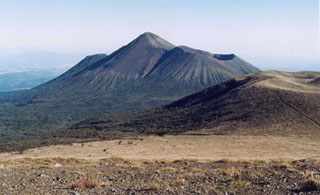Report on Kirishimayama (Japan) — 5 July-11 July 2023
Smithsonian Institution / US Geological Survey
Weekly Volcanic Activity Report, 5 July-11 July 2023
Managing Editor: Sally Sennert.
Please cite this report as:
Global Volcanism Program, 2023. Report on Kirishimayama (Japan) (Sennert, S, ed.). Weekly Volcanic Activity Report, 5 July-11 July 2023. Smithsonian Institution and US Geological Survey.
Kirishimayama
Japan
31.934°N, 130.862°E; summit elev. 1700 m
All times are local (unless otherwise noted)
JMA reported that global navigation satellite system (GNSS) data indicated minor inflation beginning in May at shallow depths beneath Ioyama, located on the NW flank of the Karakuni-dake stratovolcano in the Kirishimayama volcano group. Volcanic tremor was recorded at 1650 on 7 July for the first time since 19 June 2018. JMA raised the Alert Level to 2 (on a 5-level scale) at 1715 on 7 July and warned the public to stay 1 km away from Ioyama. A few shallow volcanic earthquakes were recorded during 7-10 July. Weather conditions mostly prevented visual observations of the fumarolic areas near the crater.
Geological Summary. Kirishimayama is a large group of more than 20 Quaternary volcanoes located north of Kagoshima Bay. The late-Pleistocene to Holocene dominantly andesitic group consists of stratovolcanoes, pyroclastic cones, maars, and underlying shield volcanoes located over an area of 20 x 30 km. The larger stratovolcanoes are scattered throughout the field, with the centrally located Karakunidake being the highest. Onamiike and Miike, the two largest maars, are located SW of Karakunidake and at its far eastern end, respectively. Holocene eruptions have been concentrated along an E-W line of vents from Miike to Ohachi, and at Shinmoedake to the NE. Frequent small-to-moderate explosive eruptions have been recorded since the 8th century.

